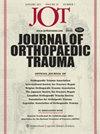A Novel Bone-Screw-Fastener Demonstrates Greater Maximum Compression Force Prior to Failure Compared to a Traditional Buttress Screw.
IF 1.6
3区 医学
Q3 ORTHOPEDICS
引用次数: 0
Abstract
This study compared the maximal compression force prior to thread stripping of the novel bone-screw-fastener (BSF) compared to the traditional-buttress-screw (TBS) in synthetic osteoporotic and cadaveric bone models. Maximum compression force of the plate-bone interface prior to loss of screw purchase during screw tightening was measured between self-tapping 3.5mm BSF and 3.5mm TBS using calibrated load cells. Three synthetic biomechanical models were used: a synthetic osteoporotic diaphysis (model 1); a 3-layer biomechanical polyurethane foam with 50-10-50 pounds-per-cubic-foot (PCF) layering (model 2), and a 3-layer polyurethane foam with 50-15-50 PCF layering (model 3). For the cadaveric metaphyseal model, three sets of cadaveric tibial plafonds and three sets of cadaveric tibial plateaus were used. A plate with sensors between the bone-plate interface was used to measure compression force during screw tightening in the synthetic bone models, while an annular load cell that measured screw compression as it slid through a guide was used to measure compression in the cadaver models. Across all synthetic osteoporotic bone models, the BSF demonstrated greater maximal compression force prior to stripping compared to the TBS (model 1, 155.51N(SD=7.77N) vs 138.78N(SD=12.74N), p=0.036; model 2, 218.14N (SD=14.15N) vs 110.23N(SD=8.00N), p<0.001; model 3, 382.72N(SD=20.15) vs 341.09N(SD=15.57N), p=0.003. The BSF had greater maximal compression force for the overall cadaver trials, the tibial plafond trials, and the tibial plateau trials (overall, 111.27N vs 97.54N(SD 32.32N), p=0.002; plafond, 149.6N vs 132.92N(SD 31.32N), p=0.006; plateau 81.33N vs 69.89N(SD 33.38N), p=0.03. The novel bone-screw-fastener generated 11-65% greater maximal compression force than the traditional-buttress-screw in synthetic osteoporotic and cadaveric metaphyseal bone models. A greater compression force may increase construct stability, facilitate early weight bearing, and reduce construct failure.与传统的对接螺钉相比,新型骨螺钉-紧固件在失效前显示出更大的最大压缩力。
本研究比较了新型骨螺钉紧固件(BSF)与传统压紧螺钉(TBS)在合成骨质疏松和尸体骨模型中螺纹剥离前的最大压紧力。 使用校准的称重传感器测量了自攻式 3.5 毫米 BSF 和 3.5 毫米 TBS 在螺钉拧紧过程中失去螺钉附着力之前板骨界面的最大压缩力。使用了三种合成生物力学模型:合成骨质疏松干骺端(模型 1)、50-10-50 磅/立方英尺(PCF)分层的三层生物力学聚氨酯泡沫(模型 2)和 50-15-50 PCF 分层的三层聚氨酯泡沫(模型 3)。在尸体骺模型中,使用了三组尸体胫骨板和三组尸体胫骨平台。在合成骨模型中,使用在骨-板界面之间装有传感器的钢板来测量螺钉拧紧时的压缩力,而在尸体模型中,使用测量螺钉滑过导板时压缩力的环形负荷传感器来测量压缩力。 在所有合成骨质疏松症骨模型中,与 TBS 相比,BSF 在剥离前显示出更大的最大压缩力(模型 1,155.5N(SD=7.77))。51N(SD=7.77N) vs 138.78N(SD=12.74N), p=0.036;模型 2, 218.14N(SD=14.15N) vs 110.23N(SD=8.00N), p<0.001;模型 3, 382.72N(SD=20.15) vs 341.09N(SD=15.57N), p=0.003。在整体尸体试验、胫骨平台试验和胫骨高原试验中,BSF 的最大压缩力更大(整体,111.27N vs 97.54N(SD 32.32N),p=0.002;平台,149.6N vs 132.92N(SD 31.32N),p=0.006;高原,81.33N vs 69.89N(SD 33.38N),p=0.03)。 在合成骨质疏松模型和尸体骺骨模型中,新型骨螺钉紧固器产生的最大压缩力比传统压紧螺钉大 11-65%。更大的压缩力可以增加结构的稳定性,促进早期负重,减少结构失败。
本文章由计算机程序翻译,如有差异,请以英文原文为准。
求助全文
约1分钟内获得全文
求助全文
来源期刊

Journal of Orthopaedic Trauma
医学-运动科学
CiteScore
3.90
自引率
8.70%
发文量
396
审稿时长
3-8 weeks
期刊介绍:
Journal of Orthopaedic Trauma is devoted exclusively to the diagnosis and management of hard and soft tissue trauma, including injuries to bone, muscle, ligament, and tendons, as well as spinal cord injuries. Under the guidance of a distinguished international board of editors, the journal provides the most current information on diagnostic techniques, new and improved surgical instruments and procedures, surgical implants and prosthetic devices, bioplastics and biometals; and physical therapy and rehabilitation.
 求助内容:
求助内容: 应助结果提醒方式:
应助结果提醒方式:


